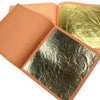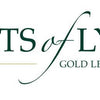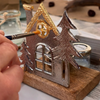Beyond the Brushstroke: Abstract and Niche Artistry with 24 Carat Gold Leaf
- by Sam Wozniak
For centuries, the brilliance of genuine gold leaf has been synonymous with majesty, wealth, and spiritual reverence. From the ancient sarcophagi of Egypt to the shimmering halos of Byzantine icons, and the intricate gilding of baroque cathedrals, the craft has been a cornerstone of monumental art and architectural restoration. Today, however, a new generation of artists and artisans is taking this timeless material and pushing its boundaries far past traditional applications.
At Wrights of Lymm, we believe the purity of 24 carat gold leaf—its rich colour, unblemished lustre, and incorruptibility—should not be confined to historical imitation. It is a premium medium, a tool for abstract expression, and a way to add unparalleled luxury and depth to modern, niche projects. If you’re looking to elevate your creative practice beyond the expected, this post explores innovative ways to use genuine goldleaf and other rare materials to create truly unique, gallery-worthy pieces.
The Philosophy of Abstract Gilding: Where Purity Meets Imperfection
The key to abstract gilding is shifting your perspective from perfect coverage to intentional contrast. Traditional restoration often requires flawless, uniform application; abstract work thrives on fragmentation, texture, and the interplay of light on the bare substrate. Using 24 carat gold leaf in this manner transforms it from a finish into a dynamic element of the composition.
The Kintsugi Principle: Golden Repairs as Art
The Japanese art of Kintsugi (golden joinery) is a profound example of abstract repair. It celebrates the history of a broken object by repairing the fracture lines with lacquer dusted or painted with pure goldleaf powder. This is a concept ripe for modern adaptation.
-
Sculptural Kintsugi: Instead of repairing broken ceramics, apply the concept to contemporary sculpture. Use 24 carat gold leaf to fill intentional cracks or gaps in concrete, carved wood, or cast resin pieces. The visible gilding doesn't hide the flaw but elevates it to a focal point, symbolizing resilience and transformation. This technique brings a surprising intimacy and value to materials traditionally considered raw or disposable, giving your work a truly monumental narrative.
-
Canvas Scarification: Apply a base of thick acrylic or texture paste to a canvas. Once dry, score or "scar" the surface deliberately. Apply size only within these lines, and use loose gold leaf to fill the trenches. The gold catches the light dramatically, representing veins, rivers, or hidden energy within the painting's landscape. The surrounding paint remains matte, enhancing the metallic contrast.
Pushing Boundaries with Mixed Media: Gold Leaf as a Structural Element
Genuine goldleaf is so thin it can feel almost immaterial, yet its presence is utterly commanding. Modern materials like epoxy resin and high-density acrylic gels offer new ways to embed, suspend, and even build with the gold, giving it unexpected weight and dimension.
Encapsulation in Resin: Suspended Gilded Worlds
Epoxy resin allows 24 carat gold leaf to be preserved in an inert, clear environment, creating three-dimensional abstract works. This moves the goldleaf from a surface treatment to an intrinsic part of the form.
-
Optical Gold-Water Layers: Create a multi-layered resin pour. In the lower layers, use very fine flakes of goldleaf suspended in a slightly tinted, translucent resin (e.g., a deep indigo or smoky grey). As you pour subsequent clear layers, the goldleaf appears to float in a deep, ethereal space. For the final top layer, apply an intentional, solid sheet of 24 carat gold leaf using gilding size to the back of the poured and cured piece, then back-fill with a solid colour. When viewed from the front, this technique creates an illusion of limitless depth, with both floating flakes and a brilliant, sharp golden horizon.
-
Botanical Monumentalisation: Preserve organic matter—a single twisted branch, a piece of barnacle-encrusted driftwood, or a collection of dried, pressed flowers—in a large resin block. Before the final pour, carefully apply 24 carat gold leaf to the surface of the embedded objects. The gilding highlights the natural imperfections and forms of the organic material, turning a simple natural element into a precious, monumental relic under glass. This is an abstract form of nature restoration, celebrating decay and preservation simultaneously.
Gilded Textures: Abstract Surfaces and Light Play
The application technique can drastically change the visual effect of goldleaf. Moving beyond a mirror-smooth finish unlocks a world of texture that plays with ambient light in fascinating, abstract ways.
Verre Églomisé Reimagined: The Subverted Mirror
Verre Églomisé, or reverse gilding on glass, is a complex technique typically used for decorative mirrors and signs. The restoration and modification of this classical technique offer stunning abstract possibilities.
-
Abstract Pattern Etching: Instead of traditional drawing, use an electric rotary tool with a fine burr to deeply engrave abstract, non-representational patterns into the back of a glass sheet. Apply traditional water gilding size and a sheet of 24 carat gold leaf over the entire surface. The gold settles into the engraved lines, creating a shimmering, tactile pattern. Next, apply a heavily textured black or dark-coloured paint over the remaining gold and the glass. When viewed from the front, the gold appears as a stark, abstract drawing suspended against a dark, rugged field. The deep texture of the paint on the back creates subtle, non-uniform reflections in the gold, preventing a flat mirror effect.
-
Distressed Gilded Windows: Apply goldleaf to a piece of glass using a cracked or distressed layer of size—perhaps by mixing the size with a medium that encourages shrinkage or separation as it dries. Once the 24 carat gold leaf is applied, it will only adhere where the size has set, resulting in an abstract mosaic of gleaming gold with deliberate gaps of clear glass. Seal this with a clear resin to protect the delicate gold, and display it where light can pass through the clear sections, casting golden, fractured patterns onto a wall.
Niche Applications: Goldleaf in the Modern Environment
For the ambitious artist or designer, gold leaf can transform entire environments, not just canvases or objects. These applications move gilding into the realm of architectural art and interior abstract design.
The Monumental Gilded Wall Treatment
Forget wallpaper; a truly monumental effect can be achieved by applying gold leaf directly to a wall or large, prepared panels in an abstract manner.
-
Deconstructed Gilding: Prime a section of wall with an abstract base colour (e.g., deep charcoal, terracotta, or matte jade). Use a stippling brush or a texture roller to apply gilding size randomly, creating a speckled or cloud-like pattern. Apply the 24 carat gold leaf over the entire area. Once brushed off, the gold will adhere only to the stippled size, resulting in a shimmering cloud or constellation effect over the matte paint. This is a dramatic, abstract treatment that speaks of luxury without the heaviness of full restoration coverage.
-
Gilded Micro-Surfaces: Utilise the high purity and brilliance of 24 carat gold leaf on unexpected materials in an installation setting. Imagine a single length of raw, industrial steel beam, with only the edges or the welding seams meticulously covered in goldleaf. Or, in a large, minimalist space, a pattern of fine, goldleaf lines applied directly to a polished concrete floor. The contrast between the industrial, raw material and the delicate, pure gold creates a powerful, abstract commentary on value and craft. These subtle gilding accents on monumental scales offer a unique, niche design statement.
The Wrights of Lymm Advantage: Quality in Abstract Art
Whether you are performing painstaking restoration, intricate gilding, or creating a raw, abstract masterpiece, the purity and consistency of your materials are paramount. The radiant, deep colour of 24 carat gold leaf provides an unmatched luxury and permanence that other materials simply cannot replicate. Embracing the abstract is not a rejection of tradition, but an evolution—a fresh way to utilise the enduring splendour of goldleaf in contemporary craft. It ensures that your unique vision, whether a small embedded charm or a monumental wall feature, will stand the test of time and light.






